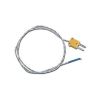Extech 5-in-1 Environmental Meter
Features
- Type K input measures temperature up to 2372° (1300°C)
- Built-in low friction vane wheel
- Utilizes precision photo diode and correction filter
- Free ground shipping
- Expedited repair and warranty service
- Lifetime technical support
- More
Overview
The Extech Hygro-Thermo-Anemometer-Light-Sound Meter is a rugged 5-in-1 environmental meter that measures humidity, temperature, air velocity, light, and sound. The characters on display can reverse direction depending on the meter mode. The built-in low friction vane wheel improves the accuracy of air velocity, the precision thin-film capacitance humidity sensor for fast response, and the thermistor for ambient temperature measurements.
Mechanics
The type K input measures temperature up to 2372°F. The meter utilizes a precision photo diode and correction filter for cosine and color-corrected light measurements. the sound level measurement meets IEC 61672 class 2 using A frequency weighting and fast response time. An optional tripod mount allows for continuous measurements.
- Air velocity
- ft/min range: 80 to 5910 ft/min
- ft/min resolution: 1ft/min
- ft/min basic accuracy: ±3% FS
- m/s range: 0.4 to 30m/s
- m/s resolution: 0.1m/s
- m/s basic accuracy: ±3% FS
- km/h range: 1.4 to 108km/h
- km/h resolution: .01km/h
- km/h basic accuracy: ±3% FS
- MPH range: 0.9 to 67MPH
- MPH resolution: 0.1PMH
- MPH basic accuracy: ±3% FS
- Light
- Foot candles range: 0 to 1860Fc
- Foot candles resolution: 0.1Fc
- Foot candles basic accuracy: ±(5% rdg + 8d)
- Lux range: 0 to 20,000Lux
- Lux resolution: 1Lux
- Lux basic accuracy: ±(5% rdg + 8d)
- Relative humidity
- RH range: 10 to 95%RH
- RH resolution: 0.1%RH
- RH basic accuracy: ±4%RH of rdg
- Temperature
- Thermistor range: 32 to 122°F (0 to 50°C)
- Thermistor resolution: 0.1°
- Thermistor basic accuracy: ±2.5°F/ 1.2°C
- Type k range: -148 to 2372°F (-100 to 1300°C)
- Type k resolution: 0.1
- Type k basic accuracy: ±(1%+2°F1°C) of rdg
- Sound
- dB range: 35 to 150dB
- dB resolution: 0.1dB
- dB basic accuracy: ±1.4dB
- Frequency range: 31.5 to 8,000Hz
- General
- Weighting/response: A weighting/fast response
- Power: 6 X AAA batteries
- Dimensions: meter, 9.8 x 2.8 x 1.3" (248 x 70 x 34mm); vane, 1.2" (31mm)
- Weight: 11.8oz (335g)
- (1) Meter
- (1) Type k thermocouple probe
- (1) Vane wheel
- (1) Windscreen
- (1) Pouch case
- (6) 1.5V AAA batteries
In The News
Save our Bogs! Culture, Conservation and Climate Action in Ireland’s Peatlands
Characterized by long-term accumulation under waterlogged conditions, peatlands exist on every continent and account for 3-4% of the global land surface . Small but mighty, these often overlooked wetland environments are estimated to hold as much as one-third of the world's organic carbon in their soil—twice the amount found in the entirety of the Earth's forest biomass. While healthy peatlands can trap and store carbon, regulate water, and provide important habitats for rare species, human alteration has disturbed peatland carbon and nitrogen cycles on a global scale. Approximately 12% of the world’s peatlands have been drained and degraded through conversion for agriculture, forestry, infrastructure development, and other uses.
Read MoreSargassum Surge: How Seaweed is Transforming our Oceans and Coastal Ecosystems
Until recently, Sargassum –a free-floating seaweed–was distributed throughout the Sargasso Sea , the north Caribbean Sea, and the Gulf of Mexico. But in the space of a decade, this seaweed has, as one scientist remarks , “Gone from a nonfactor to the source of a terrible crisis.” Driven by climate change, anomalous North Atlantic Oscillation in 2009-2010 and a glut of anthropogenic pollutants, sargassum has proliferated. Seasonally recurrent mats as deep as 7m now bloom in the “Great Atlantic Sargassum Belt” (GASB), which covers areas of the Atlantic from West Africa to the Caribbean Sea and Gulf of Mexico. Every year, millions of tons wash up along the shores of more than 30 countries . Dr.
Read MoreGreat Lakes Research Center: Designing Targeted Monitoring Solutions
According to the National Oceanic and Atmospheric Administration ( NOAA ), the Great Lakes have more miles of coastline than the contiguous Atlantic and Pacific coasts combined and contain 20 percent of the world's freshwater, making it a critical region to protect and conserve. Continuous monitoring and data-informed resource management are key components of managing waters in the region. Hayden Henderson, a research engineer with the Great Lakes Research Center (GLRC), designs and deploys monitoring platforms throughout the Great Lakes. With a background in environmental engineering, Henderson enjoyed the challenge of creating systems and making them work to obtain difficult, remote measurements.
Read More








